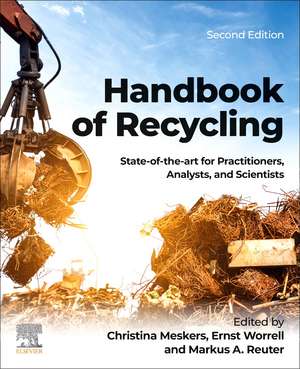Handbook of Recycling: State-of-the-art for Practitioners, Analysts, and Scientists
Editat de Christina Meskers, Ernst Worrell, Markus A. Reuteren Limba Engleză Paperback – 18 oct 2023
This book is a crucial aid to students and researchers in a range of disciplines, from materials and environmental science to public policy studies.
- Chapters authored by key experts from academia, industry, and the policymaking community
- Provides a thorough analysis from theory to practice to deeply understand the fundamentals, dynamics, complex interactions, opportunities, and challenges of recycling, within the larger picture of a circular system
- Describes the state of the art and lessons learned, to understand future challenges in recycling of a wide variety of products, materials, and waste flows
- Introduces the tools and practices to understand the opportunities and limitations of recycling in the context of a circular economy
Preț: 804.39 lei
Preț vechi: 1040.92 lei
-23% Nou
Puncte Express: 1207
Preț estimativ în valută:
153.97€ • 167.30$ • 129.42£
153.97€ • 167.30$ • 129.42£
Carte tipărită la comandă
Livrare economică 14-28 aprilie
Livrare express 14-20 martie pentru 118.07 lei
Preluare comenzi: 021 569.72.76
Specificații
ISBN-13: 9780323855143
ISBN-10: 0323855148
Pagini: 756
Dimensiuni: 191 x 235 x 41 mm
Greutate: 1.52 kg
Ediția:2
Editura: ELSEVIER SCIENCE
ISBN-10: 0323855148
Pagini: 756
Dimensiuni: 191 x 235 x 41 mm
Greutate: 1.52 kg
Ediția:2
Editura: ELSEVIER SCIENCE
Public țintă
Materials Scientists and Engineers, Mechanical Engineers in academia and R & DCuprins
Part 1 - Recycling in context
1. Introduction
2. The fundamental limits of circularity quantified by digital twinning
3. Maps of the physical economy to inform sustainability strategies
4. Material efficiency—Squaring the circular economy: Recycling within a hierarchy of material management strategies
5. Material and product-centric recycling and design for recycling rules and digital methods
6. Developments in collection of municipal waste
7. The path to inclusive recycling: Developing countries and the informal sector
Part 2 - Recycling from a product perspective
8. Physical separation
9. Sensor-based sorting
10. Mixed bulky waste
11. Packaging
12. End-of-life vehicles
13. Electrical and electronic equipment (WEEE)
14. Photovoltaic and wind energy equipment
15. Buildings
16. Construction and demolition waste
17. Industrial by-products
18. Mine tailings
Part 3 - Recycling from a material perspective
19. Steel
20. Aluminum
21. Copper
22. Lead
23. Zinc
24. Ferroalloy elements
25. Precious and technology metals
26. Concrete and aggregates
27. Cementitious binders incorporating residues
28. Glass
29. Lumber
30. Paper
31. Plastic recycling
32. Black rubber products
34. Carbon fibers
Part 4 - Recycling and the circular economy
35. From waste management to circular economy—The role of recycling in policy
36. Geopolitics of resources and recycling
37. Information and communication
38. Recycling, law, and the circular economy
39. Extended producer responsibility
40. Exploring the economics of recycling in a dynamic global context
41. Economic policy instruments
42. Economic aspects of metal recycling
Part 5 - Recycling fundamentals
43. Physical separation
44. Thermodynamics
45. Exergy—Quantification of resource dissipation
46. Process simulation—Thermodynamics and process technology to understand recycling systems
47. Life cycle assessment (LCA)
1. Introduction
2. The fundamental limits of circularity quantified by digital twinning
3. Maps of the physical economy to inform sustainability strategies
4. Material efficiency—Squaring the circular economy: Recycling within a hierarchy of material management strategies
5. Material and product-centric recycling and design for recycling rules and digital methods
6. Developments in collection of municipal waste
7. The path to inclusive recycling: Developing countries and the informal sector
Part 2 - Recycling from a product perspective
8. Physical separation
9. Sensor-based sorting
10. Mixed bulky waste
11. Packaging
12. End-of-life vehicles
13. Electrical and electronic equipment (WEEE)
14. Photovoltaic and wind energy equipment
15. Buildings
16. Construction and demolition waste
17. Industrial by-products
18. Mine tailings
Part 3 - Recycling from a material perspective
19. Steel
20. Aluminum
21. Copper
22. Lead
23. Zinc
24. Ferroalloy elements
25. Precious and technology metals
26. Concrete and aggregates
27. Cementitious binders incorporating residues
28. Glass
29. Lumber
30. Paper
31. Plastic recycling
32. Black rubber products
34. Carbon fibers
Part 4 - Recycling and the circular economy
35. From waste management to circular economy—The role of recycling in policy
36. Geopolitics of resources and recycling
37. Information and communication
38. Recycling, law, and the circular economy
39. Extended producer responsibility
40. Exploring the economics of recycling in a dynamic global context
41. Economic policy instruments
42. Economic aspects of metal recycling
Part 5 - Recycling fundamentals
43. Physical separation
44. Thermodynamics
45. Exergy—Quantification of resource dissipation
46. Process simulation—Thermodynamics and process technology to understand recycling systems
47. Life cycle assessment (LCA)
